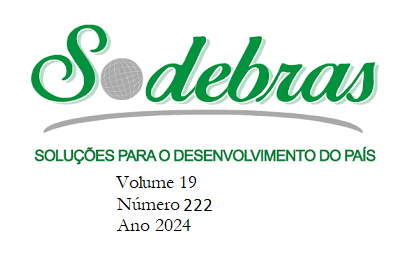PROPOSTA DE UM FRAMEWORK PARA DESENVOLVIMENTO DE AMBIENTES INDUSTRIAIS DE SIMULAÇÃO INTERATIVA
Conteúdo do artigo principal
Resumo
Os conceitos de Indústria 4.0 e Sociedade 5.0 impulsionam a convergência entre os mundos físico e digital, demandando novas abordagens para a formação e desenvolvimento de profissionais em ambientes industriais complexos e de acesso restrito. Neste contexto, este artigo propõe a criação de um framework que aplica os conceitos de realidade mista e gêmeos digitais para criar um ambiente virtual imersivo para treinamento de funcionários industriais, especificamente na manutenção de máquinas e equipamentos em subestações elétricas. O ambiente real é uma subestação elétrica que não pode ser acessada com frequência devido aos riscos de segurança aos funcionários e à impossibilidade de parar a operação de máquinas e equipamentos durante as operações da fábrica. Assim, o artigo apresenta um framework composto por cenários de treinamento baseados em tecnologias imersivas existentes para preparar os funcionários para execução de tarefas de manutenção. Inclui também a criação de uma ferramenta computacional, através de reconstrução e modelagem 3D, que permite a representação do ambiente real e a apresentação de informações (textos e vídeos) sobre os equipamentos.
Detalhes do artigo
Referências
Abracopel Homepage. Anuário Estatístico de Acidentes de Origem Elétrica 2022. Disponível em:
https://abracopel.org/wp-content/uploads/2022/04/Abracopel_Digital_Correto-final.pdf. Acesso: 05/04/2024.
ARAPAKIS, I., EFSTATHOPOULOS, E., TSITSIA, V., KORDOLAIMI, S., ECONOMOPOULOS, N., ARGENTOS, S., PLOUSSI, A., ALEXOPOULOU, E. Using "iDose4" iterative reconstruction algorithm in adults' chest-abdomen-pelvis CT examinations: Effect on image quality in relation to patient radiation exposure - Scientific Figure on ResearchGate. Available from: https://www.researchgate.net/figure/Grading-scale-for-subjective-image-quality-evaluation_tbl2_260948952>. Acesso: 23/11/2023.
BAUER, T. N. Handbook of Human Resource Management (2021).
BAUER, T. N.; ERDOGAN, B. The Oxford Handbook of Organizational Recruitment (2011).
BUCHMANN, V. et al.: FingARtips: gesture based direct manipulation in augmented reality. In: Graphite ´04: Proceedings of the 2nd international conference on computer graphics and interactive techniques in Australasia and South East Asia. New York: ACM, pp. 212-221 (2004).
CHEN, Q., et al. Photogrammetric 3D Modeling of Industrial Processes. Industrial Engineering and Management (2020).
FENG, J., ZHANG, Z. Photogrammetry-Based Quality Inspection System for Aerospace Components. Journal of Intelligent Manufacturing, 28(5), 1041–1052 (2017).
GAVISH, N., GUTIÉRREZ, T., WEBEL, S., RODRÍGUEZ, J., PEVERI, M., BOCKHOLT, U., TECCHIA, F., 2015. Evaluating virtual reality and augmented reality training for industrial maintenance and assembly tasks. Interact. Learn. Environ. 23 (6), 778–798. http://dx.doi.org/10.1080/10494820.2013.815221.
Gear Lab Homepage. How We Tested VR Headsets. Disponível em: https://www.techgearlab.com/topics/wearable-tech/best-vr-headset/how-we-test. Acesso: 10/06/2024.
GENOVESE, K., et al. Photogrammetric Techniques for the 3D Modeling of Industrial Plants. International Journal of Mechanics (2019).
HAVARD, V., JEANNE, B., LACOMBLEZ, M., BAUDRY, D. Digital twin and virtual reality: a co-simulation environment for design and assessment of industrial workstations. DOI: 10.1080/21693277.2019.1660283 (2019).
KERBL, B., KAPANAS, G., LEIMKUHLER, T., DRETTAKIS, G. “3D Gaussian Splatting for Real-Time Radiance Field Rendering.” (2023).
HE, B., LI, X., ZHOU, Y., LI, G.: Multisource Model-Driven Digital Twin System of Robotic Assembly, IEEE Systems Journal, vol. 15, no. 1, 114-123 (2021).
LI, M., FENG, X., HAN, Y.: Brillouin fiber optic sensors and mobile augmented reality-based digital twins for quantitative safety assessment of underground pipelines, Automation in Construction, Volume 144 (2022).
LIU, Q., ZHANG, Z., LI, Z. (2019). "Aerial Image Quality Analysis and Applications for UAV-based Remote Sensing." Remote Sensing, 11(3), 306.
MAKRANSKY, G., BORRE-GUDE, S., MAYER, R.E., 2019. Motivational and cognitive benefits of training in immersive virtual reality based on multiple assessments. J. Comput.
Assist. Learn. 35 (6), 691–707. http://dx.doi.org/10.1111/jcal.12375.
MIKHAIL, E. M., BETHEL, J.S., MCGLONE, J.C. Introduction to modern photogrammetry. John Wiley & Sons (2001).
OYEKAN, J.O., HUTABARAT, W., TIWARI, A., GRECH, R., AUNG, M.H., MARIANI, M.P., LÓPEZ-DÁVALOS, L., RICAUD, T., SINGH, S., DUPUIS, C.: The effectiveness of virtual environments in developing collaborative strategies between industrial robots and humans, Robotics and Computer-Integrated Manufacturing, vol. 55, Part A (2019).
PAULA FERREIRA, W., ARMELLINI, F., DE SANTA-EULALIA, L.A. Simulation in industry 4.0: A state-of-the-art review, Computers & Industrial Engineering, 1-17 (2020).
PAES, D., ARANTES, E., IRIZARRY, J. Immersive environment for improving the understanding of architectural 3D models: Comparing user spatial perception between immersive and traditional virtual reality systems. DOI: 10.1016/j.autcon.2017.09.016 (2017).
PEREZ, M. Microsoft unveils HoloLens 2: twice the field of view, eye tracking. TechCrunch. Disponível em: <https://techcrunch.com/2019/02/24/microsoft-unveils-hololens-2-twice-the-field-of-view-eye-tracking/>. Acesso: 03/11/2023.
SIYAEV, A., JO, G.-S. Towards aircraft maintenance metaverse using speech interactions with virtual objects in mixed reality. DOI: 10.3390/s21062066 (2021).
VALANDRO, R. “Tecnologia imersiva na indústria: Um framework para a construção de ambientes virtuais para simulação interativa” (2024).
YILDIZ, E., MOLLER, C., BILBERG, A. “Demonstration and evaluation of a digital twin-based virtual factory.” The International Journal of Advanced Manufacturing Technology, 114:185-203. https://doi.org/10.1007/s00170-021-06825-w. (2021).
ZHANG, M., SHU, L., LUO, X., YUAN, M., ZHENG, X., 2022. Virtual reality technology in construction safety training: Extended technology acceptance model. Autom. Constr. 135, 104113. http://dx.doi.org/10.1016/j.autcon.2021.104113.

